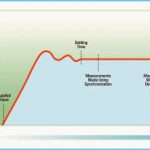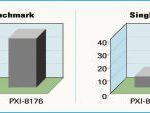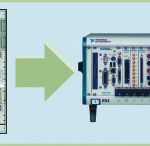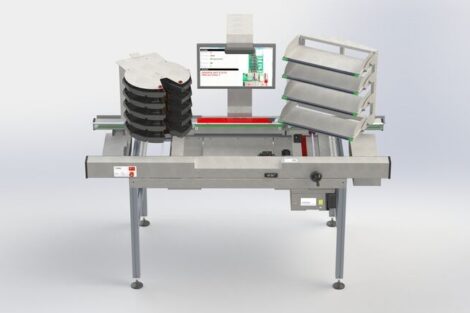There is strong demand for higher throughput and lower cost test platforms. Many have encountered the surprising trend that the cost of test is approaching, and sometimes surpassing, the material cost. Part of this trend is attributed to complex system-on-a-chip (SoC) and denser board layouts that give design engineers the ability to greatly enhance the product functions while lowering costs. But such products are also greatly increasing the functional demands placed on testers, and they are produced in cleanroom or manufacturing environments where floor space is at a cost premium. Consequently, manufacturing test systems need to increase in throughput and decrease in size and cost.
Alex McCarthy, National Instruments PXI and Instrument Control Group
The high performance and flexibility of PC technology makes it highly desirable on manufacturing floors. PC-based instruments take advantage of the low cost and compact size of PCs, while achieving higher data rates than VXI or IEC-Bus (GPIB) instruments. However, PCs are not ideally suited for a manufacturing environment. They typically have only three or four peripheral slots and are not built for a rugged rack-mount environment. Another drawback is that PCs, including industrial PCs, do not have standards for passing timing and synchronization between instruments.
CompactPCI addressed some shortcomings by combining the rugged, modular Eurocard packaging, the high-speed PCI bus, and high-performance connectors that allow for more slots. While these are important enhancements, CompactPCI did not address all the needs of manufacturing test systems. PXI (PCI eXtensions for Instrumentation) extends CompactPCI by adding dedicated timing and synchronization lines (see figure 1) and system-level specifications that simplify integration.
The PXI principle in a nutshell: the system reference clock – a 10MHz signal – is independently distributed to each PXI peripheral slot through equal-length traces. Multiple cards can use this common time base for synchronization of events. Trigger bus – eight trigger lines link all slots in a bus segment so that multiple boards can interact and control each other’s events through hardware. Star trigger – a special star trigger slot is defined which provides an independent dedicated line for each of up to 13 peripheral slots on a single backplane. When a star-trigger controller is plugged into this slot, it can be used to control, monitor or route triggers among peripheral slots with very low skew (different signal edges all within 1ns). Local bus – a right and left local bus composed of 13 lines is available to each peripheral slot for communication between adjacent slots. Pairs of peripherals can pass analog or digital signals back and forth using the local bus. PXI maintains complete interoperability with CompactPCI, while adding these features necessary to build high-performance test systems. Additionally, the equipment benefits from the high performance and low cost of PC components.
Simplified software development
PXI is based on standard Microsoft 32-bit operating systems and the PCI bus commonly found in industry-standard desktop PCs. The same software that is run on desktop PCs can be used on PXI systems without any modifications. This includes test industry software, such as National Instruments TestStand, LabView and Measurement Studio, as well as other development languages, such as Microsoft Visual C#, Visual C++ and Visual Basic. With the vast selection of test software and generic development environments, as well as the familiarity users have with the MS operating systems, users can create test systems faster.
PXI also removes one of the more painful integration and reliability problems in PC-based systems – inconsistent driver software. Driver software allows the test application to communicate with the PXI instrument hardware. With PXI, all instrument modules must include driver software. With previous test platforms, some vendors either only supplied example drivers or documentation on how to write driver software, or in some cases supplied no driver software at all. This forced integrators to spend large amounts of time writing and testing the driver software, which wasted time learning the non-essential, low-level product details necessary to write the driver. It also excluded integrators who did not have the programming capability to write drivers. PXI places the burden of driver software development and reliability where it belongs – on the vendor.
Drivers for PXI modules can be developed using native MS Windows APIs to do the low-level communication with the hardware. These drivers provide the necessary functionality to enable users to access the modules from their programs. An easier approach to developing drivers for PXI modules is using the Virtual Instrument Software Architecture (VISA) I/O library. VISA is a comprehensive standard for configuring, programming and troubleshooting instrumentation systems comprised of PXI, PCI, VXI and other interfaces across multiple operating systems including Windows, Sun Solaris and Apple’s Macintosh operating system. VISA provides the interface to development environments such as LabView, LabWindows/CVI and MS Visual Studio. Because VISA supports multiple hardware interfaces, writing and supporting instrument modules becomes easier since the core of most PXI instrument modules is also used in other hardware formats. As a result, the driver development effort can be leveraged across multiple products, resulting in more instrument modules being ported to PXI.
Higher system throughput
With PXI, users can build manufacturing test systems that deliver higher throughput with better test coverage. PXI delivers this because it leverages higher data rates, integrated timing and synchronization, PC performance evolution and optimized test software. With higher data rates, systems can reduce test time for increased throughput. PXI operates on the high-speed PCI bus and can pass data up to 132MB/s, while the VXI is limited to 40MB/s and GPIB to 8MB/s.
Optimized synchronization and triggering signals of PXI can increase the efficiency of a test system. For example, when making steady-state measurements, if the system measures the signals too early, accuracy suffers because the source output or the switching module may not have fully settled. Many test engineers insert an arbitrary delay in their programs to ensure accurate results. While this is a simple fix, test time suffers. Minimizing the delay between when the output is settled and the signal measurement is taken reduces test time (see figure 2). With PXI, test developers can route triggering signals to ensure that accurate measurements are taken as soon as possible. For complex devices, like SoCs or mixed-signal chips, the number of measurements that are delayed by even 10ms can amount to a significant increase in test time, affecting overall product profitability.
Since PXI is based on the industry-standard PC architecture, the performance improvement in PXI controllers over the past few years benefits as well. For example, the NI8156B PXI controller was launched in 1999 and provided a score of 100 in a FFT benchmark and 8,100 PID loops per second. In 2001, the then introduced NI8176 scored over 900 in the FFT benchmark and clocked 41,000 PID loops/second – for an over 400% and 500% improvement in performance, respectively (see figure 3). These PXI controllers are a modular system component, the performance of each and every instrument in the PXI-based test system being increased simultaneously just with a single processor upgrade.
Finally, since PXI is using MS Windows operating systems. Multiple vendors offer optimized test executive software. Leading test executive software solutions provide parallel testing to reduce time, simple or template-based operator interfaces, integration-to-test development tools, and reporting and database integration. For example, NI TestStand provides easy to configure parallel testing and synchronization tools for instrument sharing. These commercially available test executives are usually lower cost alternatives to in-house solutions when total development, test and support costs are included. Combining all these throughput improvements has a dramatic impact on product testing. In many cases, PXI-based testers have increased throughput by 10 to 15 times with some cases going even higher. The test-time reductions will only continue as more users leverage PXI and the latest PC technology.
PXI also saves cost by taking maximum advantage of the miniaturization of electronic components to create small, high-performance test systems. PXI provides a modular instrumentation architecture in which all modules leverage off one processor, one set of input devices, one display device and one mechanical enclosure. It is possible to implement a system into a single PXI chassis that would require an entire rack of GPIB and VXI instruments (see figure 4). This smaller footprint frees up valuable floor space and reduces overhead. The space savings can allow more products to be produced in existing facilities and postpone expansion plans, or to reduce floor-space requirements. This is critical in economic conditions where doing more with less is an indispensable requirement – not an option.
Lowered equipment and maintenance costs
By taking advantage of the standard PCI bus of PCs, PXI leverages many of the same board-level components that are used in the PC industry. These higher volume components are readily available at a lower cost. Therefore, PXI cards can be offered at a much lower cost than comparable GPIB or VXI products. Also, there is usually a higher rate of innovation in the PC industry. This leads to a broader set of PXI products available sooner in PXI than GPIB or VXI. In just five years since the introduction of the PXI standard, there are over 880 of those modules available.
The front-loading modular architecture of PXI makes maintenance and service easier. In the event of failure, users can quickly replace PXI modules without removing any fixtures from the test equipment racks. In addition, many PXI chassis include removable power supplies. In high-volume production, downtime can cost thousands-per-hour. With PXI, users can realize a mean-time-to-repair (MTTR) of less than five minutes.
Because it is built on commercial PC technology, the PXI platform continues to increase in power and versatility. With this configuration, test throughput increases while decreasing size and costs. With the combination of flexible PXI hardware and powerful test software, manufacturing test systems gain significant performance enhancements and drastic reductions in total system costs – making it the ideal platform for meeting the increasing product complexity and growing demands of manufacturers.
ZUSAMMENFASSUNG
Auch automatische Testsysteme, dereinst mal teure Aushängeschilde in Fertigungen, müssen laufend noch kompakter, leistungsfähiger und die Kosten (bezogen auf das einzelne Püfobjekt) günstiger werden. Für diese Quadratur des Kreises nimmt man die PC-Technik zur Hilfe. So haben die auf den CompactPCI-Standard aufsetzenden Systeme bereits in puncto Kosten und Datenraten den VXI- und IEC-Bus überholt. Mit PXI (PCI eXtensions for Instrumentation) aber gelingt es erst, die speziellen Timing- und Synchronisationsanforderungen zwischen den einzelnen Einschubkarten solcher komplexen Systeme optimal zu überwachen und zu steuern. Damit stehen dann auch die Möglichkeiten zur Verfügung, vollwertige und leistungsfähige automatische Tester zu konfigurieren und zu programmieren.
RESUMÉ
Les systèmes de vérification automatique, enseignes onéreuses dans la production, doivent également évoluer sans cesse vers plus de compacité, de performance et d’économie de coûts (par rapport à chaque objet de vérification en particulier). Pour cette quadrature de cercle, on s’aide de la technique PC. C’est ainsi que les systèmes installés sur le standard PCI compact ont déjà dépassé le bus VXI et IEC en matière de coût et de flux de données. Mais avec PXI (PCI extensions for instrumentation), on parvient à commander et à surveiller de façon optimale les exigences spéciales de timing et de synchronisation entre chaque carte enfichable de tels systèmes complexes. On a la possibilité de configurer et de programmer des contrôleurs automatiques complets et performants.
SOMMARIO
Anche i sistemi di test automatici, oggetti pubblicitari una volta molto costosi nelle linee di produzione, devono continuamente diventare più compatti, più efficaci e permettere una produzione a costi ridotti (in riferimento al singolo oggetto da controllare). Per questa quadratura del cerchio ci si serve della tecnica PC. In questo modo i sistemi basati sullo standard CompactPCI hanno già potuto superare dal punto di vista dei costi e delle velocità di trasferimento dati gli standard VXI e IEC-Bus. Ma con PXI (PCI Extensions for Instrumentation) si riescono a sorvegliare e a controllare in modo ottimale le rivendicazioni specifiche di timing e sincronizzazione tra le singole schede d’inserzione solamente in sistemi talmente complessi. Con ciò viene offerta anche la possibilità di configurare e programmare tester adeguati ed efficaci nonché completamente automatici.
Share:













